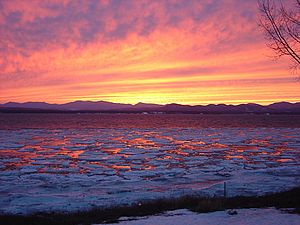Nature Note – Icy Observations

Ice forms on Lake Champlain near Hills Point in Charlotte, VT. Photo by John Winton.
Does your family enjoy a good game of Scrabble during the long winter nights? A student of lake ice formations can add such terms as frazil, nilas, and shuga to their repertoire.
Frazil are tiny needle-shaped crystals. At the outset of lake freezing they form and orient randomly. As the frazil becomes more abundant, the crystals begin to coagulate, until they join together to form the thick sheet upon which we can skate or walk.
Under calm conditions the frazil particles unite to form continuous sheets of thin transparent flexible ice known as nilas. This is the type of ice you might see as a skim on puddles after the first cold frosts of autumn. Nilas may grow to about 10 centimeters thick. After that, instead of growing vertically, water molecules begin to freeze on the bottom of the existing ice sheet increasing its thickness.
Alternatively, with even slight turbulence grease ice can form. This happens when frazil crystals clump together, forming a thin soupy layer resembling an oil slick. Over time, wind and waves can force grease ice and slush (a floating mass formed from snow and liquid water) to accumulate into spongy pieces several inches in size known as shuga. Further compression of shuga leads to larger plates called pancake ice. Pancake ice can be distinguished from shuga because the pieces have elevated rims of uniform height caused by the piling of frozen crystals at the edges when pieces bang into one another. Shuga is not dense enough to form this feature. Pancake ice also forms when ice sheets break apart.
The many types of ice on the lake provide a wealth of opportunities for study this winter.
